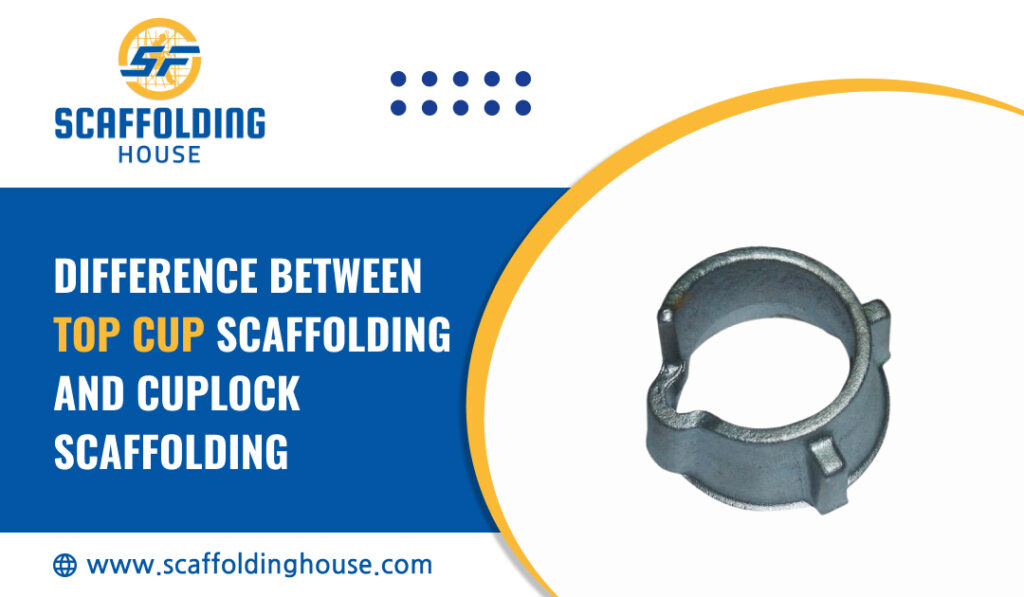Many beginners in the scaffolding industry may find it difficult to recognize the difference between top cup scaffolding and cuplock scaffolding. Most often, they consider the top cup and cuplock the same, but there are some differences. The blog will outline the differences and applications of a top cup and cuplock scaffolding.
What is a scaffolding top cup?
A top cup scaffolding is a component used to secure and stabilize the top of vertical scaffold standards. It is also called scaffold top fitting.
- Function: Mainly used in construction to join scaffolding pipes and form a secure framework.
- Placement: Positioned at the top of a vertical pipe within the scaffolding structure.
- Material: Typically crafted from malleable cast iron for strength and durability.
- Other names: Also referred to as a “scaffolding cup” or “cuplock top cup.”
What is Cuplock Scaffolding?
Cuplock scaffolding is a strong and dependable scaffolding system made up of vertical standards with cups spaced at regular intervals. These cups act as connection points for horizontal ledgers, creating a sturdy and stable structure. A standout feature of Cuplock scaffolding is its wedge-locking system, which ensures quick and secure connections, offering enhanced stability and safety for workers.
What is the difference between scaffolding top cup and cuplock scaffolding?
The term “top cup” refers to a specific part within a cuplock scaffolding system, but the main distinction is that “cuplock scaffolding” describes the entire system that uses a unique “cup” locking mechanism to join components, whereas the “top cup” is simply the movable upper part of the cup connector that facilitates quick and secure assembly. In other words, the “cuplock” is the complete scaffolding system, while the “top cup” is one individual component within it.
Function:
The cuplock system relies on multiple top cups and fixed bottom cups to secure horizontal elements like ledgers to vertical standards, forming a stable scaffolding structure.
Component vs. System:
The “top cup” is just the movable part of the connection, while the “cuplock” refers to the entire scaffolding system, which includes the top cups, bottom cups, standards, and ledgers.
How to assemble the top cup and cuplock scaffolding system?
Assembling top cup scaffolding and cuplock scaffolding systems requires careful attention to detail. Here is a list of steps to be followed to install the cuplock scaffolding system:
- Make sure the ground where you are likely to assemble the cuplock system, is stable and level.
- Place the base plates on the ground where the vertical standards are placed. These plates are used to divide the weight evenly and offer stability.
- Start positioning the vertical standards by inserting them into the base plates. Ensure they are placed at the designated intervals, and make sure they are vertical.
- Attach the bottom cups to the standards. These cups will be responsible for holding the horizontal ledgers in place.
- Add the horizontal ledgers to the bottom cups of the vertical standards. Ensure they are secure and level.
- Attach the top cups at the upper end of the vertical standards. These scaffolding top cups secure the upper ledgers and offer stability to the cuplock scaffolding system. For durable and reliable top cups, be sure to contact the best top cup scaffolding manufacturer and supplier, like Scaffolding House.
- Insert diagonal braces between the vertical standards to offer additional support and prevent swaying.
- If the ground is not even, adjust the base jacks to make sure the scaffold is stable and level.
- Conduct a thorough inspection to check the system to ensure all components are attached properly, and there are no missing parts.
Safety tips when using a top cup and cuplock scaffolding system
When installing the top cup and cuplock scaffolding system, make sure to follow a few safety precautions:
- Access points of a scaffolding system must be secured properly.
- Check for the signs of damage, wear, or loose connections periodically.
- Follow load-bearing capacities guidelines to prevent over-loading the scaffold system.
Conclusion
When using any type of scaffolding system or component, it’s essential to know their uses. Similarly, when using top cup scaffolding and cuplock scaffolding, make sure you know the difference and their uses. For top-quality top-cup scaffolding, you can contact Scaffolding House.

